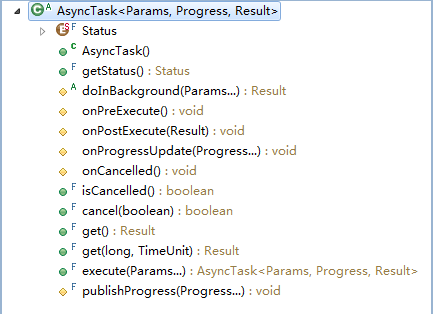二、 AsyncTask的实现基本原理
上面介绍了AsyncTask的基本应用,有些朋友也许会有疑惑,AsyncTask内部是怎么执行的呢,它执行的过程跟我们使用Handler又有什么区别呢?答案是:AsyncTask是对Thread+Handler良好的封装,在android.os.AsyncTask代码里仍然可以看到Thread和Handler的踪迹。下面就向大家详细介绍一下AsyncTask的执行原理。
我们先看一下AsyncTask的大纲视图:

源代码如下 :
我们可以看到关键几个步骤的方法都在其中。
1、doInBackground(Params... params)是一个抽象方法,我们继承AsyncTask时必须覆写此方法;
2、onPreExecute()、onProgressUpdate(Progress... values)、onPostExecute(Result result)、onCancelled()这几个方法体都是空的,我们需要的时候可以选择性的覆写它们;
3、publishProgress(Progress... values)是final修饰的,不能覆写,只能去调用,我们一般会在doInBackground(Params... params)中调用此方法来更新进度条;
4、另外,我们可以看到有一个Status的枚举类和getStatus()方法,Status枚举类代码段如下:
- //初始状态
- private volatile Status mStatus = Status.PENDING;
- public enum Status {
- /**
- * Indicates that the task has not been executed yet.
- */
- PENDING,
- /**
- * Indicates that the task is running.
- */
- RUNNING,
- /**
- * Indicates that {@link AsyncTask#onPostExecute} has finished.
- */
- FINISHED,
- }
- /**
- * Returns the current status of this task.
- *
- * @return The current status.
- */
- public final Status getStatus() {
- return mStatus;
- }
可以看到,AsyncTask的初始状态为PENDING,代表待定状态,RUNNING代表执行状态,FINISHED代表结束状态,这几种状态在AsyncTask一次生命周期内的很多地方被使用,非常重要。
在execute函数中涉及到三个陌生的变量:mWorker、sExecutor、mFuture,我们也会看一下他们的庐山真面目:
关于sExecutor,它是java.util.concurrent.ThreadPoolExecutor的实例,用于管理线程的执行。代码如下:
- private static final int CORE_POOL_SIZE = 5;
- private static final int MAXIMUM_POOL_SIZE = 128;
- private static final int KEEP_ALIVE = 10;
- //新建一个队列用来存放线程
- private static final BlockingQueue<Runnable> sWorkQueue =
- new LinkedBlockingQueue<Runnable>(10);
- //新建一个线程工厂
- private static final ThreadFactory sThreadFactory = new ThreadFactory() {
- private final AtomicInteger mCount = new AtomicInteger(1);
- //新建一个线程
- public Thread newThread(Runnable r) {
- return new Thread(r, "AsyncTask #" + mCount.getAndIncrement());
- }
- };
- //新建一个线程池执行器,用于管理线程的执行
- private static final ThreadPoolExecutor sExecutor = new ThreadPoolExecutor(CORE_POOL_SIZE,
- MAXIMUM_POOL_SIZE, KEEP_ALIVE, TimeUnit.SECONDS, sWorkQueue, sThreadFactory);
mWorker实际上是AsyncTask的一个的抽象内部类的实现对象实例,它实现了Callable<Result>接口中的call()方法,代码如下:
- private static abstract class WorkerRunnable<Params, Result> implements Callable<Result> {
- Params[] mParams;
- }
而mFuture实际上是java.util.concurrent.FutureTask的实例,下面是它的FutureTask类的相关信息:
- /**
- * A cancellable asynchronous computation.
- * ...
- */
- public class FutureTask<V> implements RunnableFuture<V> {
- public interface RunnableFuture<V> extends Runnable, Future<V> {
- /**
- * Sets this Future to the result of its computation
- * unless it has been cancelled.
- */
- void run();
- }
可以看到FutureTask是一个可以中途取消的用于异步计算的类。
下面是mWorker和mFuture实例在AsyncTask中的体现:
我们看到上面的代码中,mFuture实例对象的done()方法中,如果捕捉到了CancellationException类型的异常,则发送一条“MESSAGE_POST_CANCEL”的消息;如果顺利执行,则发送一条“MESSAGE_POST_RESULT”的消息,而消息都与一个sHandler对象关联。
我们继续按着执行流程跟踪代码,
进入到ThreadPoolExecutor的execute函数,如下 :
可以看到,这段代码的主要功能是将异步任务mFuture加入到将要执行的队列中,重要的函数为addWoker,我们继续跟踪代码到该函数。
由于mFuture是FutureTask类型,因此继续跟踪到FutureTask的代码。可以看到该构造函数,即上文中构造mFuture时用的构造函数,参数我们传递的是mWorker。
可 以 看到构造函数又将mWorker交给了Sync类型。
而启动mFuture时就会执行其中的run函数,如下 :
可知,实际上调用的是Sync的innerRun()函数,我们继续查看Sync类型。
我们看到,最后调用了set(result);我们看看这段代码 :
我们在看看sync中的innerSet方法 :
我们前面说过,在AsyncTask构造方法中创建的mFuture对象覆写了done方法,在这个方法中获取调用结果,最终通过postResult将结果投递给UI线程。
再来分析AsyncTask中的sHandler。这个sHandler实例实际上是AsyncTask内部类InternalHandler的实例,而InternalHandler正是继承了Handler,下面我们来分析一下它的代码:
- private static final int MESSAGE_POST_RESULT = 0x1; //显示结果
- private static final int MESSAGE_POST_PROGRESS = 0x2; //更新进度
- private static final int MESSAGE_POST_CANCEL = 0x3; //取消任务
- private static final InternalHandler sHandler = new InternalHandler();
- private static class InternalHandler extends Handler {
- @SuppressWarnings({"unchecked", "RawUseOfParameterizedType"})
- @Override
- public void handleMessage(Message msg) {
- AsyncTaskResult result = (AsyncTaskResult) msg.obj;
- switch (msg.what) {
- case MESSAGE_POST_RESULT:
- // There is only one result
- //调用AsyncTask.finish方法
- result.mTask.finish(result.mData[0]);
- break;
- case MESSAGE_POST_PROGRESS:
- //调用AsyncTask.onProgressUpdate方法
- result.mTask.onProgressUpdate(result.mData);
- break;
- case MESSAGE_POST_CANCEL:
- //调用AsyncTask.onCancelled方法
- result.mTask.onCancelled();
- break;
- }
- }
- }
我们看到,在处理消息时,遇到“MESSAGE_POST_RESULT”时,它会调用AsyncTask中的finish()方法,我们来看一下finish()方法的定义:
- private void finish(Result result) {
- if (isCancelled()) result = null;
- onPostExecute(result); //调用onPostExecute显示结果
- mStatus = Status.FINISHED; //改变状态为FINISHED
- }
原来finish()方法是负责调用onPostExecute(Result result)方法显示结果并改变任务状态的啊。
另外,在mFuture对象的done()方法里,构建一个消息时,这个消息包含了一个AsyncTaskResult类型的对象,然后在sHandler实例对象的handleMessage(Message msg)方法里,使用下面这种方式取得消息中附带的对象:
- AsyncTaskResult result = (AsyncTaskResult) msg.obj;
这个AsyncTaskResult究竟是什么呢,它又包含什么内容呢?其实它也是AsyncTask的一个内部类,是用来包装执行结果的一个类,让我们来看一下它的代码结构:
- @SuppressWarnings({"RawUseOfParameterizedType"})
- private static class AsyncTaskResult<Data> {
- final AsyncTask mTask;
- final Data[] mData;
- AsyncTaskResult(AsyncTask task, Data... data) {
- mTask = task;
- mData = data;
- }
- }
看以看到这个AsyncTaskResult封装了一个AsyncTask的实例和某种类型的数据集,我们再来看一下构建消息时的代码:
- //发送取消任务的消息
- message = sHandler.obtainMessage(MESSAGE_POST_CANCEL,
- new AsyncTaskResult<Result>(AsyncTask.this, (Result[]) null));
- message.sendToTarget();
- //发送显示结果的消息
- message = sHandler.obtainMessage(MESSAGE_POST_RESULT,
- new AsyncTaskResult<Result>(AsyncTask.this, result));
- message.sendToTarget();
在处理消息时是如何使用这个对象呢,我们再来看一下:
- result.mTask.finish(result.mData[0]);
- result.mTask.onProgressUpdate(result.mData);
概括来说,当我们调用execute(Params... params)方法后,execute方法会调用onPreExecute()方法,然后由ThreadPoolExecutor实例sExecutor执行一个FutureTask任务,这个过程中doInBackground(Params... params)将被调用,如果被开发者覆写的doInBackground(Params... params)方法中调用了publishProgress(Progress... values)方法,则通过InternalHandler实例sHandler发送一条MESSAGE_POST_PROGRESS消息,更新进度,sHandler处理消息时onProgressUpdate(Progress... values)方法将被调用;如果遇到异常,则发送一条MESSAGE_POST_CANCEL的消息,取消任务,sHandler处理消息时onCancelled()方法将被调用;如果执行成功,则发送一条MESSAGE_POST_RESULT的消息,显示结果,sHandler处理消息时onPostExecute(Result result)方法被调用。
经过上面的介绍,相信朋友们都已经认识到AsyncTask的本质了,它对Thread+Handler的良好封装,减少了开发者处理问题的复杂度,提高了开发效率,希望朋友们能多多体会一下。






















 303
303

 被折叠的 条评论
为什么被折叠?
被折叠的 条评论
为什么被折叠?








